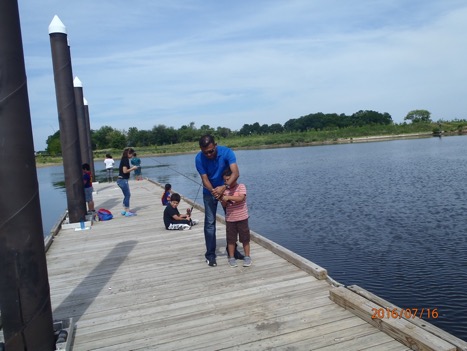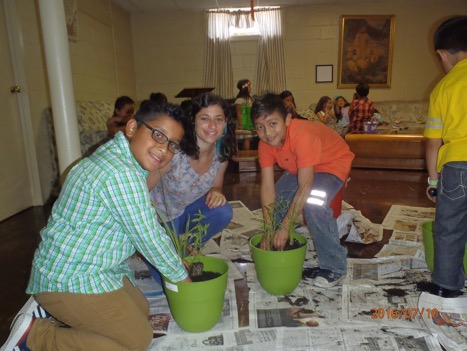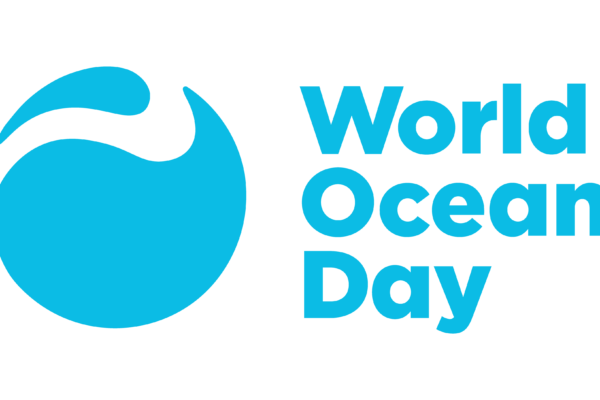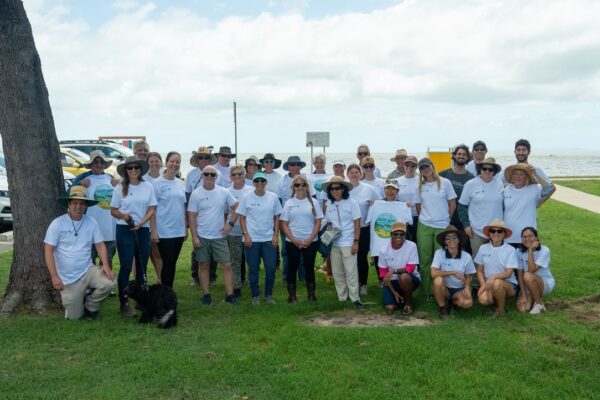This guest post, by Gabrielle Roffe and Curtis Bennett of the National Aquarium’s Conservation Department is the last in a 3-part series on their Innovative Solutions Grants+ project. This project has addressed the issue of marine debris by implementing a new approach to community engagement, with a specific focus on building our connection with the Hispanic communities near Masonville Cove in the Chesapeake Bay.
Summary
This past year, as part of The Ocean Project’s Innovative Solutions Grant+ (ISG+) Program, the National Aquarium has been trying a new approach to engage the Hispanic community throughout the South Baltimore neighborhoods of Brooklyn and Curtis Bay near Masonville Cove, the Nation’s first Urban Wildlife Refuge.
The National Aquarium recognizes the value of providing opportunities for a diversity of students and community members to participate in conservation efforts, and has prioritized urban conservation efforts. The goal of these community outreach efforts is to not only improve the health of the neighborhoods and the watershed but to strengthen the community’s connection to their local environment. While the National Aquarium’s earlier community engagement projects had been successful, we recognized that we were not doing as well with the Hispanic community, a growing demographic within our target neighborhoods. Thus, we developed this project focused specifically on creating new and innovative ways to engage Hispanic communities on an issue we knew from prior research was a common concern: marine debris. The goals of this project were twofold:
1) Engage members of the Hispanic community in the removal of debris
2) Cultivate community champions in order to ensure ongoing engagement
In order to successfully meet these goals, we had to develop a new and innovative approach to outreach, one that focused on connecting with community pillars in order to build trusting relationships.
Successes
In order to build long-lasting relationships within the Hispanic community we realized the importance of going beyond just translating outreach materials and programs into Spanish. By building trusting relationships with established pillars of the Hispanic community as outlined in our last post, we were not only able to better understand the interests of the community and inspire a more committed engagement in the project, but work towards building their capacity for future programming and project opportunities.
Our approach was to connect with community pillars including churches, schools and parent groups. Community pillars are the places or people, that community members already trust and are a source of comfort, guidance and leadership within the community. We realized that by successfully engaging community pillars, we would be able to build relationships with individual community members and ultimately reach more people as part of our programming. While we engaged a variety of groups as part of this project, our biggest success story was our relationship with the Hispanic congregation TAYR in Brooklyn. From the onset, TAYR showed this willingness to become involved in community stewardship projects and were eager to collaborate. Working together to develop shared goals and programming illustrated our commitment to one another mutually beneficial and partnership.
We were reminded that successful community partnerships take time to develop and have to be built on the foundation of mutually beneficial goals and an environment of trust. Initially we started with a long list of community pillars that we hoped to engage. We developed relationships with a Hispanic parent group at a local elementary/middle school, ESL students at a local high school, as well as TAYR. After meeting with various groups, we decided that for this project, we would focus on the quality of the relationship with TAYR rather than quantity, thus building on this genuine commitment from TAYR and ensuring that we weren’t over-extending ourselves or our resources. It was clear from the beginning that the relationship with TAYR was going to be special. We set aside time on a regular basis for meetings with Pastor Martinez and his wife, Veronica, and quickly realized that there were mutual goals. We learned about the community service and environmental project interests of the congregation and in turn, we were able to share potential program and project opportunities, primarily focused on debris prevention. These conversations helped us to collectively develop programs and events that aligned with each other’s goals and had a positive impact on both the community and the environment.
The following is a list outlining our interactions with the TAYR congregation, including program planning, promotion and facilitation:
- Regular meetings with the Pastor and his wife to plan for programs
- Attending church services and Sunday school to promote upcoming events
- Watershed 101 workshop at Masonville Cove (3 participants)
- Community cleanup in Brooklyn (114 participants)
- Native Habitat Garden Installation at the Dream Center (51 participants)
- Pollinator planting Sunday school lesson (33 participants)
- Latino Conservation Week event at Masonville Cove, including a debris clean-up, fishing, nature walk, and animal encounter (43 participants)
- Field trip to Patuxent Research Refuge (31 participants)
- Masonville Cove Fall Debris Clean-Up (6 participants)
Programming and event planning with TAYR was a collaborative process, as illustrated and outlined below for the Latino Conservation Week event at Masonville Cove. We pitched the idea of a local event in celebration of Latino Conservation Week to Pastor Martinez and Veronica and discussed what activities would be of interest to their congregation. For example, they mentioned their love of fishing and we made sure to incorporate a fishing station for children as part of the event. They even helped us to rename the event, “Conservando la Naturaleza.” This event reinforced messaging from prior Spring and Summer programming, including lessons about the watershed and how trash flows from the community into Masonville Cove, as well as lessons about the benefit of wildlife habitat in urban areas, drawing upon the experience of planting the pollinator garden in the community and importance of connecting those green spaces to Masonville Cove. This event tied all of the programming together, allowing the community to see firsthand the natural treasures they have been helping to protect.
Lessons Learned
Over the course of this project we learned how to truly address the needs of a community and meet them where they are, in their community. We started this project wondering how to overcome language and cultural barriers in order to effectively reach the Hispanic community where there was no prior relationship. Our solution was to try to build mutually beneficial partnerships with interested groups. We utilized a community pillar approach and ultimately decided to focus on relationship quality over quantity. By building a strong relationship with the TAYR congregation and having multiple opportunities to engage with them, we’ve developed a partnership that will continue to be fruitful moving forward.
We entered this program thinking that by cultivating a community champion and recognizing them as a Shore Hero, that we would foster that deeper, long-term connection. However, we found that we did not need to focus as much on recognition and awards, that the key to building a trusting relationship was finding issues of commonality and concern, to engage people in a way that is relatable. Throughout the project there was this sense that the work and overall collective impact was the true reward, a sentiment that was regularly echoed by community members. This shared feeling really helped to foster our mutually beneficial relationship.
This partnership between the National Aquarium and TAYR has been nothing short of incredible. Here is a message from TAYR, expressing what this partnership has meant to them:
“Ha sido un privilegio el poder ayudar en la comunidad porque hemos visto muchas caras alegres y las personas agradecidas por mantener un ambiente limpio y saludable. Estamos agradecidos por ser parte de estos eventos y esperamos seguir ayudando en lo que sea necesario. ¡Muchas gracias!”
“It has been a great privilege to have helped our community because we have seen many happy faces of people being thankful for keeping a clean and healthy environment. We {TAYR} are truly thankful to be a part of these events and hope to keep helping in any other community needs. Thank you!”
Community Engagement Tips and Advice
We realize that engaging a new community or audience can be time-consuming, challenging or intimidating, but there are several lessons we learned that we think can help put other aquariums and zoos in the best position to achieve success.
- Take the time to familiarize yourself with the community, in both the physical and social sense. Just by walking or driving through the neighborhoods, not only do you begin to develop this sense of place, but you gain a better understanding of community assets and resources. From a social perspective, getting to know the community will help you identify specific audiences and community pillars where you may have overlapping interests. As you start this process, make sure to go where people are: the churches, the schools, or even the local businesses like markets and restaurants and reach out to them in a real and authentic way and people are likely to respond positively.
- Remember that building trusting community relationships is a two-way street, you have to get to know the community but you also have to give the community time to get to know you. It’s important to set aside time to meet in person with representatives of these community pillars to discuss their needs and interests and outline your programmatic goals as well. And because of the time commitment involved, recognize that you may need initially to prioritize, as we did, quality over quantity.
- From there focus on opportunities to create mutually beneficial goals in order to create a collaborative effort. The importance of collaboration, in all phases of the programmatic process, from development to implementation, can’t be overstated. Once you’ve established partnerships with community pillars, additional opportunities can become available to build new connections with other community pillars. At the end of the day, we found that successful community engagement should focus on that human interaction, showing that you care and are available to listen and provide support.
Moving Forward
For the National Aquarium, the success of this project to engage the Hispanic communities within Brooklyn and Curtis Bay can be attributed to going beyond just translating educational and outreach materials but translating our programmatic experiences to ensure that they were relatable. While this is the culmination of The Ocean Project’s ISG+ grant, this is truly just the beginning of the work that we will continue to do with Hispanic communities. Pastor Martinez is currently working with us to reach out to other Hispanic churches in the area, to vouch for our relationship so we can start building new ones and expanding our efforts. We also want to focus on capacity building throughout the community, to ensure that community groups have the ability and are ready to participate in future program and project efforts.






